Solar eclipse of May 11, 2097
| Solar eclipse of May 11, 2097 | |
|---|---|
| Type of eclipse | |
| Nature | Total |
| Gamma | 0.8516 |
| Magnitude | 1.0538 |
| Maximum eclipse | |
| Duration | 190 s (3 min 10 s) |
| Coordinates | 67°24′N 149°30′W / 67.4°N 149.5°W |
| Max. width of band | 339 km (211 mi) |
| Times (UTC) | |
| Greatest eclipse |
|
| References | |
| Saros | 149 (25 of 71) |
| Catalog # (SE5000) | 9726 |
A total solar eclipse will occur at the Moon's ascending node of orbit on Saturday, May 11, 2097, with a magnitude of 1.0538. A solar eclipse occurs when the Moon passes between Earth and the Sun, thereby totally or partly obscuring the image of the Sun for a viewer on Earth. A total solar eclipse occurs when the Moon's apparent diameter is larger than the Sun's, blocking all direct sunlight, turning day into darkness. Totality occurs in a narrow path across Earth's surface, with the partial solar eclipse visible over a surrounding region thousands of kilometres wide.
Related eclipses[edit]
Eclipses in 2097[edit]
- A partial lunar eclipse on April 26, 2097.
- A total solar eclipse on May 11, 2097.
- A total lunar eclipse on October 21, 2097.
- An annular solar eclipse on November 4, 2097.
Metonic[edit]
- Preceded by: Solar eclipse of July 23, 2093
- Followed by: Solar eclipse of February 28, 2101
Tzolkinex[edit]
- Preceded by: Solar eclipse of March 31, 2090
- Followed by: Solar eclipse of June 22, 2104
Half-Saros[edit]
- Preceded by: Lunar eclipse of May 5, 2088
- Followed by: Lunar eclipse of May 17, 2106
Tritos[edit]
- Preceded by: Solar eclipse of June 11, 2086
- Followed by: Solar eclipse of April 11, 2108
Solar Saros 149[edit]
- Preceded by: Solar eclipse of May 1, 2079
- Followed by: Solar eclipse of May 24, 2115
Inex[edit]
- Preceded by: Solar eclipse of May 31, 2068
- Followed by: Solar eclipse of April 22, 2126
Triad[edit]
- Preceded by: Solar eclipse of July 11, 2010
- Followed by: Solar eclipse of March 12, 2184
Solar eclipses of 2094–2098[edit]
This eclipse is a member of a semester series. An eclipse in a semester series of solar eclipses repeats approximately every 177 days and 4 hours (a semester) at alternating nodes of the Moon's orbit.[1]
| 119 | June 13, 2094 Partial |
124 | December 7, 2094 Partial |
| 129 | June 2, 2095 Total |
134 | November 27, 2095 Annular |
| 139 | May 22, 2096 Total |
144 | November 15, 2096 Annular |
| 149 | May 11, 2097 Total |
154 | November 4, 2097 Annular |
| 164 | October 24, 2098 Partial |
Saros 149[edit]
This eclipse is a part of Saros series 149, repeating every 18 years, 11 days, and containing 71 events. The series started with a partial solar eclipse on August 21, 1664. It contains total eclipses from April 9, 2043 through October 2, 2331; hybrid eclipses from October 13, 2349 through November 3, 2385; and annular eclipses from November 15, 2403 through July 13, 2800. The series ends at member 71 as a partial eclipse on September 28, 2926. Its eclipses are tabulated in three columns; every third eclipse in the same column is one exeligmos apart, so they all cast shadows over approximately the same parts of the Earth.
The longest duration of totality will be produced by member 31 at 4 minutes, 10 seconds on July 17, 2205, and the longest duration of annularity will be produced by member 62 at 5 minutes, 6 seconds on June 21, 2764. All eclipses in this series occur at the Moon’s ascending node of orbit.[2]
| Series members 9–30 occur between 1801 and 2200: | ||
|---|---|---|
| 9 | 10 | 11 |
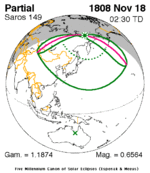 November 18, 1808 |
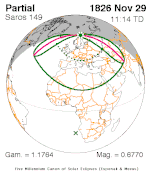 November 29, 1826 |
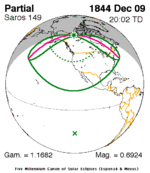 December 9, 1844 |
| 12 | 13 | 14 |
 December 21, 1862 |
 December 31, 1880 |
 January 11, 1899 |
| 15 | 16 | 17 |
 January 23, 1917 |
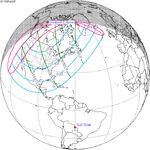 February 3, 1935 |
 February 14, 1953 |
| 18 | 19 | 20 |
 February 25, 1971 |
 March 7, 1989 |
 March 19, 2007 |
| 21 | 22 | 23 |
 March 29, 2025 |
 April 9, 2043 |
 April 20, 2061 |
| 24 | 25 | 26 |
 May 1, 2079 |
 May 11, 2097 |
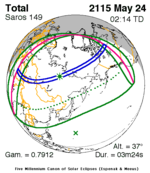 May 24, 2115 |
| 27 | 28 | 29 |
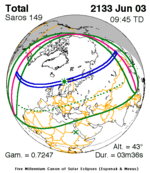 June 3, 2133 |
 June 14, 2151 |
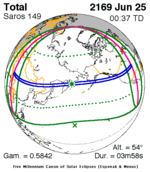 June 25, 2169 |
| 30 | ||
 July 6, 2187 | ||
Notes[edit]
- ^ van Gent, R.H. "Solar- and Lunar-Eclipse Predictions from Antiquity to the Present". A Catalogue of Eclipse Cycles. Utrecht University. Retrieved 6 October 2018.
- ^ "NASA - Catalog of Solar Eclipses of Saros 149". eclipse.gsfc.nasa.gov.
References[edit]
- Earth visibility chart and eclipse statistics Eclipse Predictions by Fred Espenak, NASA/GSFC




